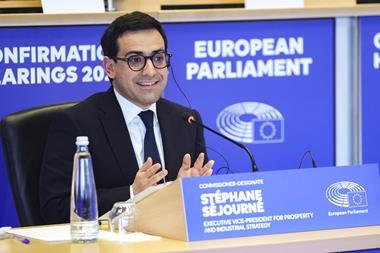The Climate Bonds Initiative has started an ambitious journey into climate resilience finance as it joins forces with the UN Office for Disaster Risk Reduction (UNDRR) to launch a new white paper to guide the development of a taxonomy for adaptation and resilience finance investment.
The paper – Designing a climate resilience classification framework – comes ahead of the Summit for a New Global Financing Pact in Paris this week where resilience is a crucial part of the discussions on building a fairer and more inclusive international financial system.
It also follows on the political declaration adopted by heads of states and ministers by the UN General Assembly last month which called on countries to step up investments in disaster risk reduction and promote “the development of innovative instruments and tools to finance disaster risk reduction, such as resilience bonds”.
Sean Kidney, chief executive officer of Climate Bonds Initiative, said: “The planet is set for a future of climate reckoning and we must be equipped with resilience solutions for diligent stewardship of the challenges ahead. Arming the sustainable finance movement with a resilience taxonomy can best place us to channel capital to fight against our planet’s plight, alongside continuing efforts towards adaptation and mitigation.”
Abhilash Panda, deputy chief of intergovernmental processes, interagency cooperation and partnerships branch, at UNDRR, added: “As we strive towards a safer and more resilient future, it is critical to increase investment in disaster risk reduction. We need to leverage multiple sources of finance, both public and private, and align them with an evidence-based approach to resilience.”
The white paper sets out seven climate resilience systemic themes:
- resilient agri-food systems;
- resilient cities;
- resilient health;
- resilient infrastructure;
- resilient industry and commerce;
- resilient nature and biodiversity; and
- resilient societies.
The paper offers scope of what resilience would look like for each of those themes by identifying the guiding principles and prototype structure of a resilience taxonomy. It also sets out the initial scope of a climate resilience pipeline, enabling investors and companies to identify resilience opportunities.
It includes a call for action by providing a Terms of Reference for industry experts to join the efforts to collaboratively develop the taxonomy. UNDRR and Climate Bonds Initiative are inviting industry experts, scientists, and academics to join the working groups and contribute their expertise to this vital project.
Additionally, UNDRR is convening a set of influential investors to advance financing solutions for resilience, through an Investor Advisory Board, which will further explore pathways for this resilience taxonomy to help mobilise capital markets resources for climate adaptation and disaster risk reduction.
Fidelity International launches ESG tool for members
Fidelity International has launched a new tool, ‘Fidelity Illuminate’, to provide its members with an opportunity to share their views on ESG decisions made by the companies included in their workplace pension savings.
The tool is the latest development resulting from Fidelity’s partnership with impact-focused fintech Tumelo, as it continues to develop tools and services which support the sustainable investing needs of its workplace investing clients and members.
Illuminate allows members to view where their pension is invested, including the company shares they hold within this. The tool allows them to express their opinions on ESG issues relating to those companies in the form of a vote preference. This preference is submitted to the fund manager in a collective view of Fidelity Illuminate members’ opinions, for consideration as part of their voting at company annual general meetings (AGMs). The fund manager’s vote and final AGM result will be available to members.
The tool is integrated with PlanViewer, Fidelity’s workplace investing platform, meaning members can engage with their savings and benefit from a range of practical features in one place, without the need for multiple logins.
Dan Smith, head of workplace distribution at Fidelity International, said: “Workplace pension members are investors in some of the world’s biggest and most influential organisations, and increasingly want to share their views on the ESG decisions these companies make. Fidelity Illuminate provides an opportunity for them to have a voice on the issues which matter to them.”
Zoological Society of London launches biodiversity guide for pensions industry
The Zoological Society of London (ZSL) has released a first of its kind biodiversity risk guide for the pensions industry.
The new guide to greener saving provides a step-by-step approach for pension trustees to comprehensively tackle biodiversity loss and nature risk in investments, it was announced.
Developed by conservation charity ZSL in collaboration with CACEIS Investor Services, the new guide offers practical insights and tips to trustees, covering essential aspects such as the current challenges of biodiversity risk, the definition of biodiversity, key drivers of biodiversity loss, risks to pension schemes, and how trustees can initiate the evaluation of biodiversity risk within their schemes.
ZSL senior sustainable finance specialist James Pilkington said: “Saving for our future will mean nothing if there is no future to save for.”
He said that 44% of the global economy is dependent on the services nature provides, and according to ZSL’s Living Planet Index, which tracks human pressures and impacts on the natural world, there has been an average 69% decrease in monitored global wildlife populations between 1970 and 2018.
“People today paying into pensions should be confident that their investments will not harm the environment: as asset owners and investors the finance sector has a significant responsibility in mitigating the biodiversity crisis, and as a major part of the industry the pensions sector is no exception. But make no mistake it’s a complicated topic,” Pilkington said.
The latest digital edition of IPE’s magazine is now available












No comments yet